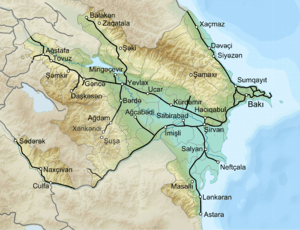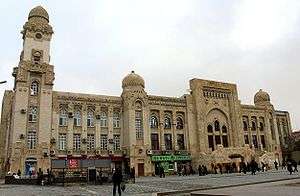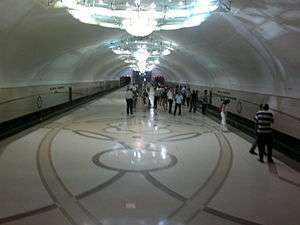Rail transport in Azerbaijan
| Azerbaijan | |
|---|---|
 Azerbaijan railway network | |
| Operation | |
| National railway | Azərbaycanda Dəmiryolu |
| System length | |
| Total | 2,932 kilometres (1,822 mi) |
| Double track | 815 kilometres (506 mi) |
| Electrified | 1,272 kilometres (790 mi) |
| Freight only | 810 kilometres (500 mi) |
| High-speed | 0 kilometres (0 mi) |
| Track gauge | |
| Main | 1,520 mm (4 ft 11 27⁄32 in) |
| Electrification | |
| 25 kV 50 Hz | Main network |
Rail transport in Azerbaijan is operated by the national state-owned railway company Azerbaijan Railways (Azerbaijani: Azərbaycanda Dəmiryolu). The railway network consists of 2,918 km (1,813 mi), its gauge is 1,520 mm (4 ft 11 27⁄32 in) (Russian broad gauge), 815 km (506 mi) are double track and 1,272 km (790 mi) are electrified at 3 kV (3,000 V) DC.[1]
Azerbaijan's location and infrastructure have contributed to the vibrant transport sector of the country. Railways take up 16.7% of Azerbaijan's freight traffic flows. Throughout 2005-2009, a massive railway modernisation programme was initiated.[2] Expansions costing $795 million were announced in 2012 to respond to the growing demand for rail transport in the country.[3] Also Stadler Rail and local partner International Railway Distribution LLC announced the formation of a 51:49 joint venture on July 17, 2014.[4]
History
Russian Imperial Railways 1878-1917
The first railway line in Azerbaijan then belonging to the Russian Empire was laid in 1878 and was opened in 1880 within the suburban range of Baku, which led from Sabunçu to Suraxanı, today situated within the city of Baku. The track width corresponded to the Russian 1,520 mm (4 ft 11 27⁄32 in) gauge.
The first long-distance railway line was opened in 1883, which led from Baku to Tbilisi in Georgia.
In 1900 railway lines were opened which connected Baku via Biləcəri with Derbent and Petrovsk (Makhachkala) in Dagestan and thus connected Azerbaijan with the rest of the Russian Empire (and later the Soviet Union).
In 1908 with extension of the railway line from Ararat in Armenia to Şərur and Julfa in the Nakhchivan exclave of Azerbaijan, this part of Azerbaijan was connected with Armenia.
Thus the development of the Azerbaijani Railway was for the time being considered final.
Soviet Railways 1917-1991
After the collapse of the Russian Empire and the Russian Revolution the country was transformed into the Soviet Union and the Russian Imperial Railways into the Soviet Railways.
Due to the availability of electricity from the vast water power sources of Azerbaijan, the very early electrification of the railway lines of Azerbaijan began. In 1926 with the electrification with 1,2 kV (1,200 V) direct current of the railway line between Baku and Sabunçu, it became the first electrically operated railway line of the Soviet Union. Later electrifications took place with 3 kV (3,000 V) direct current.
In 1924 the railway line was extended southwards to Ələt and Neftçala.
In 1941 the railway line was extended from Horadiz and Mincivan through Armenia including a railway line extension to Kapan, to Julfa in the Nakhchivan exclave of Azerbaijan. Thus the Nakhchivan exclave of Azerbaijan was finally connected with Azerbaijan proper.
In 1941 the railway line was also extended southwards to Astara, Azerbaijan at the southern border with Iran.
In 1944 the railway line was extended to Kətəlparaq, Ağdam and Stepanakert (Xankəndi).
Until 1991 the railway traffic was operated in Azerbaijan by the Soviet Railway under supervision of the Soviet Traffic Ministry. The Azerbaijani branch of the Soviet Railways was divided into three departments of Baku, Gəncə and Nakhchivan City.

Azerbaijan Railways (Azərbaycan Dəmir Yolları) 1991-
With the independence of the Republic of Azerbaijan in 1991, the Azerbaijan State Railways (Azərbaycan Dövlət Dəmir Yolları) was formed the same year.
Network
There are 2,932 km (1,822 mi) kilometers of rail tracks out of which only 2,117 km (1,315 mi) are in common carrier service and 810 km (500 mi) are industrial lines.[1] 240 km (150 mi) of rail tracks were occupied by Armenia between 1988 and 1994 and due to Armenian occupation, the railway link between Nakhichevan and Azerbaijan proper has been broken since 1991.
Of the 2,932 km (1,822 mi) of rail tracks, 72% or 2,117 km (1,315 mi) are single track and 28% or 815 km (506 mi) are double track.[1]
Of the total exploitation length of route 43% or 1,272 km (790 mi) are electrified at 3 kV (3,000 V) DC.[1]
About 38% of the length of the railway routes or 1,126 km (700 mi) are equipped with full automatic blocks and 16% or 479 km (298 mi) are equipped with centralized dispatchers.[1]
The railways has 176 stations, 2 of which, Bilajari and Shirvan are completely automated, 12 stations have container courts with adapted mechanisms and machines, 3 stations – Keşlə, Ganja and Khirdalan are able to supply high cargo containers.
In freight traffic, the exportation of oil from the oil wells from Baku at the Caspian Sea to the Georgian port of Batumi at the Black Sea, forms an important share of the rail transport in Azerbaijan. The freight market share of the Azerbaijan State Railway was 21% in 1999. The freight market share of the railways are also expected to rise rapidly with completion of the Kars–Tbilisi–Baku railway. Much of the rail track and rolling stock is in need of repair or replacement.
The national network has no high-speed lines and is not served by high-speed trains.
Rail links to adjacent countries

-
 Russia - yes - 1,520 mm (4 ft 11 27⁄32 in) gauge.
Russia - yes - 1,520 mm (4 ft 11 27⁄32 in) gauge. -
 Georgia - yes - 1,520 mm (4 ft 11 27⁄32 in) gauge - also new 1,435 mm (4 ft 8 1⁄2 in) standard gauge link to Turkey (under construction - due to be completed in 2014).
Georgia - yes - 1,520 mm (4 ft 11 27⁄32 in) gauge - also new 1,435 mm (4 ft 8 1⁄2 in) standard gauge link to Turkey (under construction - due to be completed in 2014). -
 Iran - yes - break-of-gauge 1,520 mm (4 ft 11 27⁄32 in) - 1,435 mm (4 ft 8 1⁄2 in) (only from Nakhichevan, planned link to Azerbaijan proper for building Russia-Iran corridor).
Iran - yes - break-of-gauge 1,520 mm (4 ft 11 27⁄32 in) - 1,435 mm (4 ft 8 1⁄2 in) (only from Nakhichevan, planned link to Azerbaijan proper for building Russia-Iran corridor). -
 Turkey - no - break-of-gauge 1,520 mm (4 ft 11 27⁄32 in) - also new 1,435 mm (4 ft 8 1⁄2 in) standard gauge via Georgia (Kars–Tbilisi–Baku railway, under construction - due to be completed in 2015).
Turkey - no - break-of-gauge 1,520 mm (4 ft 11 27⁄32 in) - also new 1,435 mm (4 ft 8 1⁄2 in) standard gauge via Georgia (Kars–Tbilisi–Baku railway, under construction - due to be completed in 2015). -
 Armenia - yes - 1,520 mm (4 ft 11 27⁄32 in) gauge - closed because of the ongoing Nagorno-Karabakh conflict between Armenia and Azerbaijan.
Armenia - yes - 1,520 mm (4 ft 11 27⁄32 in) gauge - closed because of the ongoing Nagorno-Karabakh conflict between Armenia and Azerbaijan.
Urban railways
Baku is the only city with a metro system, the Baku Metro. The network consists of two lines. Plans to expand the metro are underway, with additional subway systems to be constructed in Azerbaijan's most populated and developed cities.[5]
See also
References
- 1 2 3 4 5 "Azerbaijan Railways". Indexmundi. 2009-12-19. Retrieved 2007-11-01.
- ↑ "Azerbaijan Transport and Logistics". East Invest. Retrieved 30 December 2014.
- ↑ "AZERBAIJAN RAIL TRADE AND TRANSPORT FACILITATION PROJECT". http://www.traceca-org.org/fileadmin/fm-dam/Investment_Forum/AZR1_Baku-Alyat-Beyuk-Kesik_Railway_Rehabilitation.pdf. Traceca. External link in
|journal=(help); - ↑ "Stadler forms joint venture in Azerbaijan". Retrieved 17 July 2014.
- ↑ "Baku Metro, French company ink agreement on tunnels construction". Retrieved 7 January 2015.
External links
| Wikimedia Commons has media related to Rail transport in Azerbaijan. |
- Azerbaijan Railways Official Site (Azerbaijani)
- Gallery and Information of the Electric Locomotives of the Azerbaijan Railways
- "Schematic Map of the Azerbaijan Railway Network" (in Russian). Archived from the original on January 31, 2013.
- "Gallery and Information of the Electric Locomotives of the Azerbaijan Railways" (in Russian). Archived from the original on January 31, 2013.
